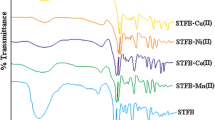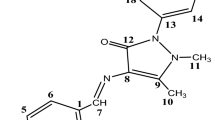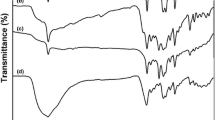Abstract
A novel ligand 2,5-bis(p-tolylcarbamoyl)terephthalic acid (3) was synthesized by using pyromellitic dianhydride (1) with p-toluidine (2). Novel coordination polymers 4(a-f) of this ligand were prepared by using various metal salts viz. Mn(II), Fe(II), Co(II), Ni(II), Cu(II) and Zn(II). The coordination polymers and ligand were characterized by physicochemical, thermogravimetric and spectroscopic techniques. Electronic spectral analysis and magnetic measurement studies were taken into account for the geometry of coordination polymers. Polymeric properties like, Number average molecular weight (\( \overline{\mathrm{Mn}} \)) and Degree of polymerization (DP) has also been carried out. Antimicrobial activity was carried out against various strains of bacteria and spores of fungi. Compounds (3 and 4a–f) were evaluated for their antibacterial activity against Gram-positive bacterial strains (Bacillus subtilis [BS] and Staphylococcus aureus [SA]) and Gram-negative bacterial strains (Salmonella typhimurium [ST] and Escherichia coli [EC]) utilizing the agar diffusion assay. Growth inhibition was compared with the standard drug ciprofloxacin. Compounds (3 and 4a–f) were also examined for antifungal activity against different fungal strains, i.e. Penicillium expansum [PE], Botryodiplodia theobromae [BT], Nigrospora sp. [NS], Trichothesium sp. [TS]. The antifungal drug, ketoconazole was used as a positive control.






Similar content being viewed by others
References
Allendorf MD, Bauer CA, Bhaktaa RK, Houka RJT (2009) Luminescent metal–organic frameworks. Chem Soc Rev 38:1330–1352
Ma S, Sun D, Forster PM, Yuan D, Zhuang W, Chen YS, Parisez JB, Zhou HC (2009) A three-dimensional porous metal − organic framework constructed from two-dimensional sheets via interdigitation exhibiting dynamic features. Inorg Chem 48:4616–4618
Sun D, Xu QJ, Ma CY, Zhang N, Huang RB, Zheng LS (2010) Self-assembly, thermal stability and photoluminescence of two mixed-ligand silver(I) networks via 2D-2D and 2D-3D parallel interpenetration of (4,4) nets. Cryst Eng Comm 12:4161–4167
Pan ZR, Xu J, Yao XQ, Li YZ, Guo ZJ, Zheng HG (2011) Syntheses, structures, magnetic and photoluminescence properties of metal–organic frameworks based on aromatic polycarboxylate acids. Cryst Eng Comm 13:1617–1624
Sun D, Liu FJ, Huang RB, Zheng LS (2013) Structural diversity of Ag/3-nitrophthalate coordination polymers controlled by solvent and induction agent. Cryst Eng Comm 15:1185–1193
Sun D, Wei ZH, Yang CF, Wang DF, Zhang N, Huang RB, Zheng LS (2011) pH-Dependent Ag(I) coordination architectures constructed from 4-cyanopyridine and phthalic acid: from discrete structure to 2D sheet. Cryst Eng Comm 13:1591–1601
Zhao F, Jing S, Che Y, Zheng J (2012) Metal–ligand ratio-controlled assembly of two pairs of Co(II) complexes: syntheses, structures and magnetic properties. Cryst Eng Comm 14:4478–4485
Li HH, Ma N, Li KH (2012) A 3d mesomeric supramolecular structure of a cu(ii) coordination polymer with 1,1′-biphenyl-2,2′,3,3′ tetracarboxylic acid and 5,5′-dimethyl-2,2′-bipyridine ligands. J Inorg Organomet Polym 22(6):1320–1324
Tong ML, Hu S, Wang J, Kitagawa S, Ng SW (2005) Supramolecular isomerism in cadmium hydroxide phases. Temperature-dependent synthesis and structure of photoluminescent coordination polymers of ∞- and β-Cd2(OH)2(2,4-pyda). Cryst Growth Des 5:837–839
Wu ST, Long LS, Huang RB, Zheng LS (2007) pH-dependent assembly of supramolecular architectures from 0D to 2D networks. Cryst Growth Des 7:1746–1752
Lu WG, Jiang L, Lu TB (2010) Lanthanide contraction and temperature-dependent structures of lanthanide coordination polymers with imidazole-4,5-dicarboxylate and oxalate. Cryst Growth Des 10:4310–4318
Hagrman PJ, Hagrman D, Zubieta J (1999) Organic–inorganic hybrid materials: from “simple” coordination polymers to organodiamine-templated molybdenum oxides. Angew Chem Int Ed 38(18):2638–2684
Khlobystov AN, Blake AJ, Champness NR, Lemenovskii DA, Majouga AG, Zyk NV, Schröder M (2001) Supramolecular design of one-dimensional coordination polymers based on silver(I) complexes of aromatic nitrogen-donor ligands. Coord Chem Rev 222:155–192
Yaghi OM, Keeffe MO, Ockwig NW, Chae HK, Eddaoudi M, Kim J (2003) Reticular synthesis and the design of new materials. Nature 423:705–714
Moulton B, Zaworotko M (2001) From molecules to crystal engineering: supramolecular isomerism and polymorphism in network solids. Chem Rev 101:1629–1639
Du M, Jiang XJ, Zhao XJ (2006) Controllable assembly of metal-directed coordination polymers under diverse conditions: a case study of the mii − H3tma/Bpt mixed-ligand system. Inorg Chem 45:3998–4006
Paz FAA, Klinowski J (2004) Two- and three-dimensional cadmium − organic frameworks with trimesic acid and 4,4′-trimethylenedipyridine. Inorg Chem 43:3882–3893
Abourahma H, Moulton B, Kravtsov V, Zaworotko MJ (2002) Supramolecular isomerism in coordination compounds: nanoscale molecular hexagons and chains. J Am Chem Soc 124:9990–9991
Varughese S, Pedireddi VR (2006) A competitive molecular recognition study: syntheses and analysis of supramolecular assemblies of 3,5-dihydroxybenzoic acid and its bromo derivative with some n-donor compounds. Chem Eur J 12(6):1597–1600
Wang XL, Qin C, Wang EB (2006) Polythreading of infinite 1d chains into different structural motifs: Two poly(pseudo-rotaxane) architectures constructed by concomitant coordinative and hydrogen bonds. Cryst Growth Des 6:439–443
Yang GP, Wang YY, Ma LF, Liu JQ, Wu YP, Wu WP, Shi QZ (2007) Hydrothermal syntheses and characterizations of three coordination polymers based on mixed organic ligands. Eur J Inorg Chem 24:3892–3898
Wang JJ, Gou L, Hu HM, Han ZX, Li DS, Xue GL, Yang ML, Shi QZ (2007) Ligand and pH-controlled Zn(II) bilayer coordination polymers based on biphenyl-3,3′,4,4′-tetracarboxylate. Cryst Growth Des 7:1514–1521
Zang SQ, Su Y, Li YZ, Ni ZP, Zhu HZ, Meng QJ (2006) Interweaving of triple-helical and extended metal − o − metal single-helical chains with the same helix axis in a 3d metal − organic framework. Inorg Chem 45(10):3855–3857
Duan X, Lin J, Li Y, Zhu C, Meng Q (2008) Syntheses, structures and properties of a series of organic–inorganic complexes based on methylenediisophthalic acid (H4MDIP). Cryst Eng Comm 10:207–216
Zang S, Su Y, Duan C, Li Y, Zhu H, Meng Q (2006) Coexistence of chiral hydrophilic and achiral hydrophobic channels in one multi-helical-array metal–organic framework incorporating helical water cluster chains. Chem Commun 4997–4999
Zang SQ, Su Y, Li YZ, Lin JG, Duan XY, Meng QJ, Gao S (2009) Four 2D metal–organic networks incorporating Cd-cluster SUBs: hydrothermal synthesis, structures and photoluminescent properties. Cryst Eng Comm 11:122–129
Mei CZ, Shan WW, Liu BT (2011) Synthesis, crystal structure and luminescent properties of one 3D Cd(II) coordination polymer [Cd(H3BPTC)2(bpy)]n (H4BPTC = 1,1′-biphenyl-2,2′,6,6′-tetracarboxylic acid, bpy = 4,4′-bipyridine). Spectrochim Acta A Mol Biomol Spectrosc 81(1):764–768
Mei CZ, Wang JX, Shan WW (2011) Synthesis and crystal structure of an infinitesandwich-type Cu(i) coordination polymer:{[Cu(abpy)2](H3bptc)·(H2O)}n constructedby a tetracarboxylic acid. Chin J Struct Chem 8:1194–1198
Huang YG, Gong YQ, Jiang FL, Yuan DQ, Wu MY, Gao Q, Wei W, Hong MC (2007) Formation of an infinite three-dimensional water network by the hierarchic assembly of bilayer water nanotubes of octamers. Cryst Growth Des 7:1385–1387
Patel YS, Patel HS, Srinivasulu B (2012) Synthesis, spectral, magnetic, thermal and biological aspects of pyromellitic dianhydride based co-ordination polymers. Int J Plast Technol 16(2):117–124
Patel YS, Patel HS (2012) Co-ordination polymers derived from pyromellitic diamic acid: synthetic, spectral, magnetic, thermal and biological aspects. Elixir Appl Chem 44:7238–7242
Patel YS, Patel KD, Patel HS (2012) Spectral and antimicrobial studies on novel ligand and its co-ordination polymers Journal of Saudi Chemical Society. http://dx.doi.org/10.1016/j.jscs.2012.11.008
Vanparia SF, Patel TS, Sojitra NA, Jagani CL, Dixit BC, Patel PS, Dixit RB (2010) Synthesis, characterization and antimicrobial study of novel 4-{[(8-hydroxyquinolin-5-yl)methyl]amino} benzenesulfonamide and its oxinates. Acta Chim Slov 57:660–667
Vogel AI (1961) A textbook of quantitative inorganic analysis, 3rd edn. Longman, London
Jeffery GH, Bassett J, Mentham J, Denney RC (1989) Vogel’s textbook of quantitative inorganic analysis, 5th edn. Longman, Harlow
Chatterjee SK, Gupta ND (1973) Effects of structure and composition on the titration curves of some synthetic copolymers in nonaqueous media. J Polym Sci Polym Chem Ed 11:1261–1270
Alam S (2004) Synthesis, antibacterial and antifungal activity of some derivatives of 2-phenyl-chromen- 4-one. J Chem Sci 116:325–332
Pelzar MJ, Chan ECS, Krieg NR (1998) Antibiotics and other chemotherapeutic agents in microbiology, 5th edn. Blackwell Science, New York
Silverstein RM, Webste FX (2004) Spectrometric identification of organic compounds, 6th edn. John Wiley & Sons, New York
Panchal PK, Pansuriya PB, Patel MN (2006) In-vitro biological evaluation of some ONS and NS donor Schiff’s bases and their metal complexes. J Enz Inhib Med Chem 21:453–458
Nakamoto K (1978) Infrared and raman spectra of inorganic and coordination compounds, 3rd edn. Wiley, New York
Lever ABP (1984) Electronic spectra of dn inorganic electronic spectroscopy, 2nd edn. Elsevier, Amsterdam
Malik A, Parveen S, Ahamad T, Alshehri SM, Singh PK, Nishat N (2010) Coordination polymer: synthesis spectral characterization and thermal behaviour of starch-urea based biodegradable polymer and its PolymerMetal complexes. Bioinorg Chem Appl. doi:10.1155/2010/848130
Soliman EM, El-Shabasy M (1994) Synthesis, characterization and electrical conductivity properties of homo- and hetero-di and trimetallic complexes of mixed azo dyes. J Mater Sci 29:4505–4509
Lewis J, Wilkins RS (1960) Modern co-ordination chemistry. Wiley Interscience, New York
Papplardo R (1960) Note on the optical absorption of MnCl2 and MnBr2. J Chem Phys 33:613–614
Tweedy BG (1964) Plant extracts with metal ions as potential antimicrobial agents. Phytopathology 55:910–914
Chohan ZH, Arif M, Shafiq Z, Yaqub M, Supuran CT (2006) In vitro antibacterial, antifungal & cytotoxic activity of some isonicotinoylhydrazide Schiff’s bases and their cobalt (II), copper (II), nickel (II) and zinc (II) complexes. J Enzym Inhib Med 21(1):95–103
Chohan ZH, Supuran CT (2005) Organometallic compounds with biologically active molecules: in vitro antibacterial and antifungal activity of some 1,1′-(dicarbohydrazono) ferrocenes and their cobalt(II), copper(II), nickel(II) and zinc(II) complexes. Appl Organomet Chem 19(12):1207–1214
Acknowledgments
One of the authors Yogesh S. Patel is greatly thankful to UGC for sanctioning his Teacher Fellowship Under the Scheme of Faculty Improvement Programme for the research work.
Author information
Authors and Affiliations
Corresponding author
Rights and permissions
About this article
Cite this article
Patel, Y.S., Patel, H.S. & Srinivasulu, B. Synthesis, characterization and biological evaluation of coordination polymers synthesized from 2,5-bis(p-tolylcarbamoyl)terephthalic acid. Int J Plast Technol 18, 49–63 (2014). https://doi.org/10.1007/s12588-014-9064-1
Received:
Accepted:
Published:
Issue Date:
DOI: https://doi.org/10.1007/s12588-014-9064-1




